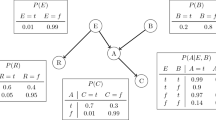Abstract
In this paper we propose an algorithm for structure learning in predictive expert systems based on a probabilistic network representation. The idea is to have the “simplest” structure (minimum number of links) with acceptable predictive capability. The algorithm starts by building a tree structure based on measuring mutual information between pairs of variables, and then it adds links as necessary to obtain certain predictive performance. We have applied this method for ozone prediction in México City, where the ozone level is used as a global indicator for the air quality in different parts of the city. It is important to predict the ozone level a day, or at least several hours in advance, to reduce the health hazards and industrial losses that occur when the ozone reaches emergency levels. We obtained as a first approximation a tree-structured dependency model for predicting ozone in one part of the city. We observe that even with only three parameters, its estimations are acceptable.
A causal network representation and the structure learning techniques produced some very interesting results for the ozone prediction problem. Firstly, we got some insight into the dependence structure of the phenomena. Secondly, we got an indication of which are the important and not so important variables for ozone forecasting. Taking this into account, the measurement and computational costs for ozone prediction could be reduced. And thirdly, we have obtained satisfactory short term ozone predictions based on a small set of the most important parameters.
Similar content being viewed by others
References
H.A. Simon, “Why machines should learn?,” in Machine Learning, edited by R.S. Michalski, T.M. Mitchell, and J. Carbonell, Morgan-Kaufmann: Los Altos, CA, pp. 25–37, 1983.
J. Pearl, “On evidential reasoning on a hierarchy of hypothesis,” Artificial Intelligence, vol. 28, pp. 9–15, 1986.
J. Pearl, Probabilistic Reasoning in Intelligent Systems, Morgan-Kaufmann: San Mateo, CA, 1988.
K.C. Ng and B. Abramson, “Uncertainty management in expert systems,” IEEE Expert, April 1990.
J. Kim and J. Pearl, “A computational model for combined causal and diagnostic reasoning in inference systems,” in Proceedings IJCAI, 1983, pp. 190–193.
S.L. Lauritzen and D.J. Spiegelhalter, “Local computations with probabilities on graphical structures and their application to expert systems,” J.R. Stat. Soc. B: vol. 50,no. 2, pp. 157–224, 1988.
G.F. Cooper, “The computational complexity of probabilistic inference using Bayesian networks,” Artificial Intelligence, vol. 42, pp. 393–405, 1990.
C.K. Chow and C.N. Liu, “Approximating probability distributions with dependence trees,” IEEE Trans. on Information Theory, vol. 14,no. 3, pp. 462–468, 1968.
G. Rebane and J. Pearl, “The recovery of causal poly-trees from statistical data,” in Uncertainty in Artificial Intelligence 3, edited by L.N. Kanal, T.S. Levitt, and J.F. Lemmer, North-Holland: Amsterdam, pp. 175–182, 1989.
L.E. Sucar, D.F. Gillies, and D.A. Gillies, “Objective probabilities in expert systems,” Artificial Intelligence, vol. 61, pp. 187–208, 1993.
C.K. Kwoh and D.F. Gillies, “Using hidden nodes in Bayesian networks,” Artificial Intelligence, vol. 88, pp. 1–38, 1996.
S. Srinivas, S. Russell, and A. Agogino, “Automated construction of sparse Bayesian networks from unstructured probabilistic models and domain information,” in Uncertainty in Artificial Intelligence 5, edited by M. Henrion, R.D. Shachter, L.N. Kanal, and J.F. Lemmer, North-Holland: Amsterdam, pp. 295–308, 1990.
G.F. Cooper and E. Herskovits, “A Bayesian method for the induction of probabilistic networks from data,” Machine Learning, vol. 9, pp. 309–347, 1992.
W. Lam and F. Bacchus, “Learning Bayesian networks: An approach based on the MDL principle,” Computational Intelligence, vol. 10,no. 2, pp. 269–293, 1994.
T. Verma and J. Pearl, “Causal networks: Semantics and expressiveness,” in Uncertainty in Artificial Intelligence 4, edited by R.D. Shachter, T.S. Levitt, L.N. Kanal, and J.F. Lemmer, North-Holland: Amsterdam, pp. 69–76, 1990.
J.C. Ruiz-Suárez, O.A. Mayora, R. Smith-Pérez, and L.G. Ruiz-Suárez, “A neural network-based prediction model of ozone for México City,” in Air Pollution II, edited by J.M. Baldsano, C.A. Brebbia, H. Power, and P. Zannetti, vol. 1, pp. 393–400, 1994.
L.E. Sucar, J. Pérez-Brito, and J.C. Ruiz-Suárez, “Induction of dependence structures from data and its application to ozone prediction,” in Proceedings Eight International Conference on Industrial and Engineering Applications of Artificial Intelligence and Expert Systems (IEA/AIE), edited by G.F. Forsyth and M. Ali, DSTO: Australia, 1995, pp. 57–63.
J.R. Quinlan, C4.5: Programs for Machine Learning, Morgan Kaufmann: San Mateo, CA, 1993.
Author information
Authors and Affiliations
Rights and permissions
About this article
Cite this article
Sucar, L.E., Pérez-Brito, J., Ruiz-Suárez, J.C. et al. Learning Structure from Data and Its Application to Ozone Prediction. Applied Intelligence 7, 327–338 (1997). https://doi.org/10.1023/A:1008265520889
Issue Date:
DOI: https://doi.org/10.1023/A:1008265520889




